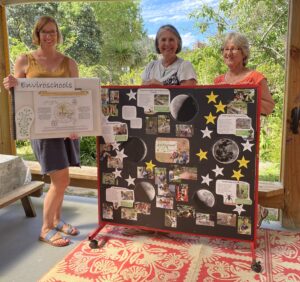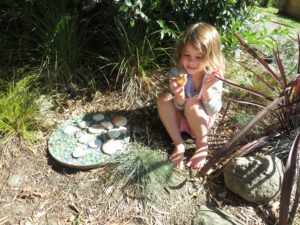
The teaching team at Parihaka Kindergarten share their pool of knowledge of their Enviroschools journey.
Our journey of being guided by the maramataka truly began after the first lockdown in 2020. At that point we were looking at ways in which we could safeguard our individual and collective wellbeing. We wanted to use the predictable and meaningful indigenous knowledge that allowed us to plan for the highs and lows that life was throwing our way.
We endeavoured to plan the days and months ahead, and regardless of the challenging time, were confident that our plans could be achieved by using our growing knowledge and tuning in to the energies surrounding us. Keeping a daily journal of our energy levels and activities supported our growing understanding, through observations, of the influence of the maramataka on our daily lives.
Our teaching team was ambitious and, alongside this exploration, we were also implementing other projects – the main one being setting up a weekly Ngahere programme for our tamariki. This coincided with beginning our Enviroschools journey. The further we moved along our maramataka path, the more we could see how both of these other projects lined up with the direction that we were shaping.
As we sat together to kōrero about our bronze reflection, we looked at the Enviroschools five Guiding Principles, the kaupapa of Enviroschools, and the 5 main moon phases within the maramataka calendar. Each phase brings with it a different energy and focus, ensuring balance and wellbeing as we move through the days, months and years.
With our growing understanding of how we could use these concepts (in both our short- and long-term planning), we recognised the correlation between the kaupapa of Enviroschools and using the maramataka. We could see how awareness of these phases and concepts could positively influence our reflective mahi at bronze level and help set our goals for the future. The principles sit within all of the maramataka phases and vice versa to some degree, and we have shifted them around as we have increased our knowledge and reflected on our practice.

Using taonga from Tangaroa on the “give back” phase of Huna.
The 5 key moon phases within the maramataka calendar for us are: Whiro, Tamatea Āio, Te Rākaunui, Korekore Tuatahi and Tangaroa-ā- Mua. Each day within each phase gives off a slightly different energy as it increases or decreases according to the lunar calendar, but in general, each phase was either a time to start building up or slowing down and was a time of high, average or low energy.
Different activities and events work best at different times, and we could see how this could align with the Enviroschools Guiding Principles of Empowered Students, Learning for Sustainability, Māori Perspectives, Respect for the Diversity of People and Culture and Sustainable Communities.
In its broadest sense, and as a starter for us to further explore, we defined the activities and actions that can take place during the maramataka and their links to the Guiding Principles.
Empowered Students are enabled to participate in meaningful ways in the life of their early childhood centre or school. Their unique perspectives are valued for the knowledge and insight that they bring, and they are supported to take action for real change. This linked strongly with Te Rākaunui – Me whai tikanga, “be purposeful in your actions”.
It is a time to be active, to plan big from knowing and move forward. There is a strong collective energy and a time to come together and work on shared goals. It is a time to share experiences, work on projects and build a sense of togetherness! Energy is very high at this time and can become a little manic, but it is a time when ideas and brainstorming can lead you in new directions!
Learning for Sustainability recognises the types of teaching and learning that use connecting experiences to develop holistic and ecological perspectives, foster student enquiry, decision-making, action, and reflection, and create sustainable outcomes. We could see the energy of the Tangaroa-ā- Mua – Me Pukumahi, “be productive” phase coming through with this principle.
Anything connected with water and the sustainability of this taonga is valuable during this phase. It is a time to give thanks, to take what you need but also replenish resources for the time ahead. It’s a time to be productive, to do the mahi, to spend time outside. It is a time to give thanks, to move and learn together, to question, and work to benefit those in the future. This is a high energy time and very productive!
Māori Perspectives honours the status of tangata whenua in this land and the value of indigenous knowledge and wisdoms in enriching and guiding learning and action. Maori perspectives are woven through all aspects of our kaupapa but aligned most strongly with the Korekore Tuatahi phase.
During this time, we encourage working together, mahi tahi and work collectively for the benefit of all. We tautoko others, show manaaki, share resources, feed the mind, spend time with whanau, organise ourselves for the high energy ahead and be ready! It is a time of low energy, so a good time to rest and take a breath and share the load. A great time to korero and build relationships and seek knowledge.
Respect for the diversity of People and Communities acknowledges the unique gifts, contributions and perspectives of individuals and groups, reinforcing the value of participatory decision-making and collaborative action. This sat strongly within the Tamatea Āio phase.
Me tūpato – Be careful. It is a time to discuss new learnings, to celebrate the knowledge and people around you and what we all bring. It is a time to be prepared for the unexpected, to be able to answer questions, to do your homework, to call on experts, and to take on different perspectives. It is a time of average energy and a good time to contemplate and absorb information. It is a time to work slowly but steadily towards your goals.
Sustainable Communities act in ways that nurture people and nature, now and in the future, to maintain the health and viability of our environment, society, culture and economy. The Whiro phase was a good fit for this principle.
Me pūmahara- be insightful and strategic. During Whiro it’s a good time to concentrate on home and bring your thoughts and actions back to the community. It’s a time to reflect and gather insights, to talk to your community and plan for the days and months ahead. It’s a time to contemplate, review what has been achieved and what was not. It’s a time to strengthen relationships and to be mindful of what you do and where you are.

Now look at that! Inspecting the tomato growth in the māra kai.
Our activities, conversations, actions, engagement and planning all now align with these phases as we incorporate them into our daily, weekly, monthly and yearly goals. It allows us to work consistently throughout this time, having time to take a breather, times when we are very productive, time to work steadily and make time to contemplate and review our progress.
It allows us time to work with our communities in different ways and incorporate and build on our place-based learning programme in a way that works best for our community, strengthening our links to where we stand and how we can culturally sustain our place here, now and into the future.
The intensity of the levels of energy also varies according to the strength of each moon and as we move through the seasons. There are so many variables, so it is important to be flexible and to take note of the specifics surrounding each day, phase and season, noting the tohu, the signs. Our weekly visits into the ngahere on the maunga, Parihaka, where we stand allows us to build our observation skills and gain deeper insights and knowledge.
As time goes on and we continue to build on the ways in which using the maramataka can be used in our everyday mahi, the more we realise we that we have so much more to learn! The more we discern about our specific environment, the more knowledge we gain about how the maramataka informs what happens here in this place and how we can use that knowledge to create a healthy, peaceful and sustainable community.
Our Vision for Parihaka Kindergarten is:
Parihaka
Tū Tonu Stand steadfast
Tū Kāha Stand with strength
Tū Pakari Stand with Integrity
Tū Māia Stand with Courage
Applying the Enviroschools principles and utilising the knowledge of our ancestors will provide us with the ability to live our vision!